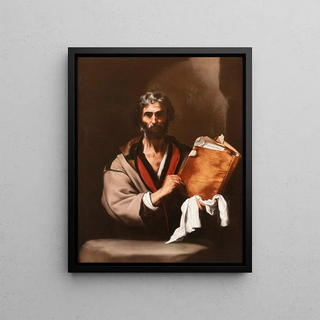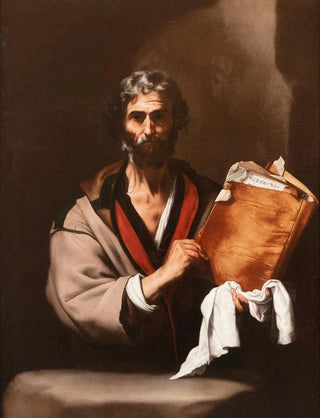Art print | A philosopher (Case conflict) - Jusepe de Ribera Source: Reproduction | Un philosophe (Conflit de cas) - Jusepe de Ribera


View from behind

Frame (optional)
"Un philosophe (Conflit de cas)" art print by Jusepe de Ribera is a true invitation to delve into the complex universe of 17th-century Spain. This canvas, embodying the quintessence of Baroque art, stands out for its emotional intensity and intellectual depth. It is not merely a simple depiction but engages the viewer in a philosophical dialogue about the human condition. The confrontation between wisdom and passion, doubt and certainty, is palpable in every brushstroke, every play of shadow and light. This piece, emblematic of its period, still resonates today, prompting us to reflect on our own beliefs and existential questions.
Style and uniqueness of the art print
The uniqueness of "Un philosophe (Conflit de cas)" lies in Ribera's exceptional mastery in capturing dramatic tension. The contrast between deep shadows and bright highlights creates an almost theatrical atmosphere, where each character appears caught in a moment of intense reflection. The meticulous details, from facial expressions to the drapery of clothing, testify to striking realism. Influenced by Caravaggio, Ribera employs chiaroscuro techniques to emphasize the emotions of the protagonists, making the artwork lively and dynamic. This Baroque style, both rich and expressive, transcends the simple pictorial frame to become a true exploration of the human soul, where philosophy and art meet in a harmonious dance.
The artist and his influence
Jusepe de Ribera, often nicknamed "the Spagnoleto," is one of the most influential artists of 17th-century Spanish painting. Born in Játiva, near Valencia, he established himself in Naples, where he built a reputation thanks to his undeniable talent and unique style. Influenced by Italian masters, Ribera developed an approach that combines realism and spirituality. His work goes beyond simple representations of daily life; it explores profound themes such as suffering, death, and the search for truth. By integrating elements of classical culture and philosophical thought, he created a distinctive artistic language that continues to inspire today.

Matte finish

View from behind

Frame (optional)
"Un philosophe (Conflit de cas)" art print by Jusepe de Ribera is a true invitation to delve into the complex universe of 17th-century Spain. This canvas, embodying the quintessence of Baroque art, stands out for its emotional intensity and intellectual depth. It is not merely a simple depiction but engages the viewer in a philosophical dialogue about the human condition. The confrontation between wisdom and passion, doubt and certainty, is palpable in every brushstroke, every play of shadow and light. This piece, emblematic of its period, still resonates today, prompting us to reflect on our own beliefs and existential questions.
Style and uniqueness of the art print
The uniqueness of "Un philosophe (Conflit de cas)" lies in Ribera's exceptional mastery in capturing dramatic tension. The contrast between deep shadows and bright highlights creates an almost theatrical atmosphere, where each character appears caught in a moment of intense reflection. The meticulous details, from facial expressions to the drapery of clothing, testify to striking realism. Influenced by Caravaggio, Ribera employs chiaroscuro techniques to emphasize the emotions of the protagonists, making the artwork lively and dynamic. This Baroque style, both rich and expressive, transcends the simple pictorial frame to become a true exploration of the human soul, where philosophy and art meet in a harmonious dance.
The artist and his influence
Jusepe de Ribera, often nicknamed "the Spagnoleto," is one of the most influential artists of 17th-century Spanish painting. Born in Játiva, near Valencia, he established himself in Naples, where he built a reputation thanks to his undeniable talent and unique style. Influenced by Italian masters, Ribera developed an approach that combines realism and spirituality. His work goes beyond simple representations of daily life; it explores profound themes such as suffering, death, and the search for truth. By integrating elements of classical culture and philosophical thought, he created a distinctive artistic language that continues to inspire today.






